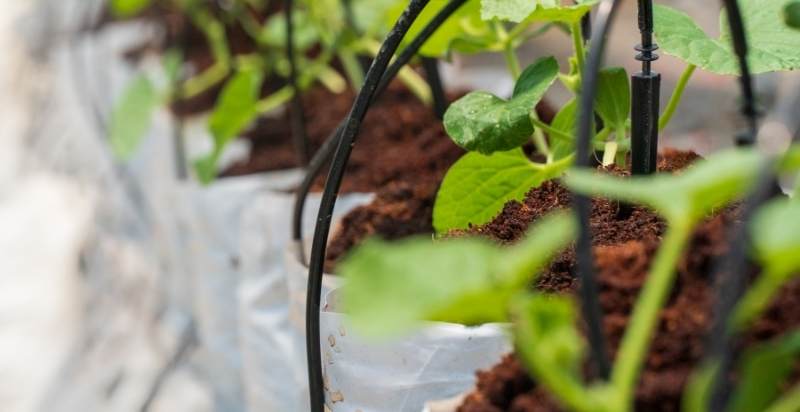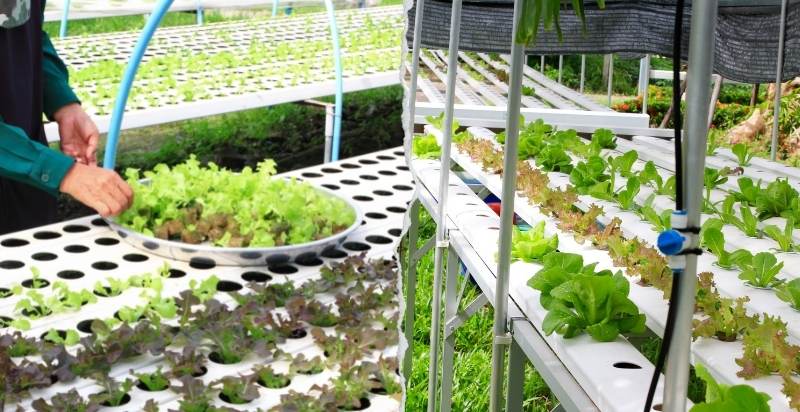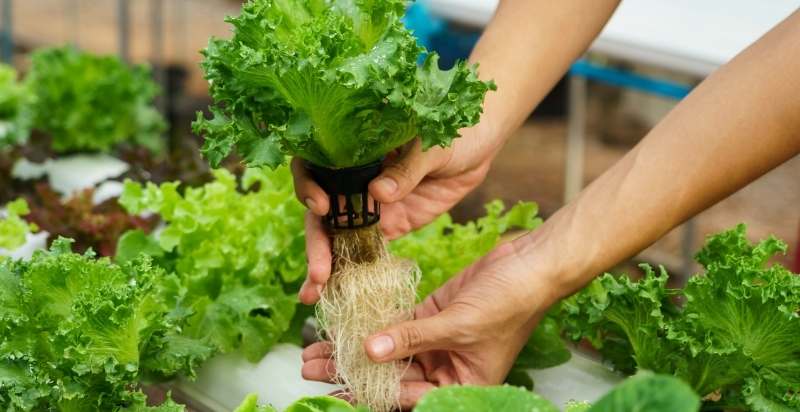If you’re looking for an interesting and unique way to garden, then hydroponics may be the perfect option for you. Hydroponic gardening is a method of growing plants without soil, using a nutrient-rich water solution in place of soil. This can be a great way to grow plants indoors or in small spaces, and it’s also a great option for those new to gardening. This article will discuss the basics of hydroponic gardening and provide step-by-step instructions for getting started. So if you’re excited about the prospect of growing your plants hydroponically, keep reading!
What is Hydroponic Gardening, And How Does It Work?
Hydroponic gardening is a type of gardening that uses no soil, instead relying on a nutrient solution to provide plants with the necessary nutrients for growth. Plants are grown in a growing medium, such as gravel or perlite, and their roots are constantly bathed in the nutrient solution. Hydroponics can be used to grow vegetables and flowers and can be done indoors or outdoors.
Hydroponics is often seen as a type of “clean” gardening since no soil is involved, and this means there is less chance of harmful bacteria or fungi contaminating the plants. Additionally, because hydroponics gardens can be controlled more easily than traditional gardens, it is possible to create a consistent environment for the plants, leading to higher yields.
Hydroponic gardening is a great way to grow plants without using soil. Using a hydroponic system, you can provide your plants with all the nutrients they need to thrive while keeping them free of harmful bacteria and fungi.
Types Of Hydroponic Gardens:
Like there are different types of gardens, there are also different types of hydroponic gardens. The three most popular types are wicked systems, ebb and flow systems, and drip systems.
Wick System: A wick system is the simplest type of hydroponic garden. It consists of a growing medium (usually vermiculite or perlite), a reservoir for the nutrient solution, and a wick that delivers the solution to the roots of the plants.
Ebb and Flow System: An ebb and flow system are slightly more complex than a wick system. It uses a pump to deliver the nutrient solution to the plants and then allows it to drain back into the reservoir. This cycle is repeated several times throughout the day.
Drip System: A drip system is the most complex type of hydroponic garden. It uses a pump to deliver the nutrient solution to the plants, but it also has a timer that controls how often the solution is delivered. This allows the roots to get the right amount of water and nutrients.
No matter what type of hydroponic system you use, it is important to ensure that the plants’ roots always have access to oxygen. This can be done by using a grow light or by placing the plants in an area where they will get plenty of natural light.

Benefits Of Hydroponic Gardening Over Traditional Soil Gardening:
There are many benefits to hydroponic gardening over traditional soil gardening. One of the biggest benefits is that plants grown hydroponically often grow much faster than those grown in soil. This is because the plant roots have direct access to nutrients and water, which they can use immediately. The plant does not need to search for food and water, as it would if it were growing in soil.
Another benefit of hydroponic gardening is that it is much easier to control the environment in which the plants are growing. For example, if you want to provide your plants with extra light, you can add more lights to the system. If you want to increase the humidity, you can add a humidifier. By controlling the environment, you can ensure that your plants get exactly what they need to grow quickly and healthily.
Finally, hydroponic gardening is much easier on the back than traditional soil gardening. There is no need to dig, hoe, or weed the garden beds. All the work is done indoors, so you don’t have to worry about the weather or insects. You can also grow plants in a small space, which is great for people who live in apartments or other small spaces.
How to Decide Which One You Need?
The type of hydroponic garden you need will depend on a few factors, including the type of plants you want to grow, the size of your garden, and your budget.
A wick system is a good option if you’re starting because it’s simple and relatively inexpensive. An ebb-and-flow or drip system might be better if you want to grow more complex plants or have a larger garden.
Finally, if you’re on a tight budget, you can always build your hydroponic garden. Plenty of DIY plans and kits are available online; make sure to do your research before you get started!
How To Start A Hydroponic Garden In Your Own Home?
Hydroponic gardening is a great way to grow plants without needing soil, and all you need is water, nutrients, and a growing medium. You can grow hydroponically almost anywhere, including in your own home.
Starting a hydroponic garden at home is easy and doesn’t require a lot of equipment or space. Here are the steps you need to take to get started:
1. Choose the right location: Hydroponic gardens can be set up almost anywhere as long as there is adequate lighting. Choose a south-facing window or install grow lights if you are growing indoors.
2. Set up your system: Many types of hydroponic systems are available, so choose the one that best suits your needs. You can purchase a complete system or build your own using recycled materials.
3. Choose your plants: Almost any plant can be grown hydroponically, but some are better suited to this gardening method than others. Start with easy-to-grow plants such as lettuce, tomatoes, or herbs.
4. Add nutrients to the water: Plants need nutrients to grow, so you must add them to the water in your hydroponic garden. You can purchase nutrient solutions at most garden stores or online.
5. Monitor your plants: Keep an eye on your plants and ensure they get the right amount of water, light, and nutrients. Make adjustments as needed to ensure they are healthy and happy.
With a little effort, you can easily start a hydroponic garden in your home. This gardening is fun, rewarding, and a great way to grow your food.

Tips For Keeping Your Hydroponic Garden Healthy And Thriving:
Here are a few tips to keep your hydroponic garden healthy and thriving:
- Make sure you use the right kind of water. Hydroponic plants need clean, filtered water free of impurities and chemicals. You can use a water filter to remove impurities from your tap water, or you can collect rainwater for your garden.
- Keep your garden well-ventilated. Hydroponic gardens need fresh air to prevent the buildup of mold and mildew. Be sure to open a window or door in your grow room to allow fresh air to circulate.
- Inspect your plants regularly for pests and diseases. If you notice any problems, treat them immediately with the appropriate pest control products.
- Keep your garden clean. Remove dead leaves and debris from your grow room to prevent the spread of diseases. Wipe down surfaces with a damp cloth to remove any dirt or grime.
- Make sure your plants get enough light. Most hydroponic plants need at least six hours of direct sunlight each day. If you are growing plants indoors, you will need to supplement natural sunlight with artificial lighting.
- Water your plants regularly. Hydroponic plants need to be watered more frequently than plants grown in soil because they have no roots to absorb water from the ground. Be sure to check the moisture level of your grow medium regularly and water your plants as needed.
- Feed your plants the right nutrients. Hydroponic plants need a balanced diet of essential nutrients to grow and thrive. You can use commercial hydroponic fertilizer or mix your own with organic matter and minerals.
- Prune your plants as needed. Trimming back yellow or dead leaves can help improve the overall health of your plants. In addition, pruning can also stimulate new growth and promote bushier, fuller plants.
- Harvest your crops when they are ripe. Each plant has its own ideal harvest time, so consult a gardening guide before you harvest your crops.
- Take care of your hydroponic system. Regular maintenance is essential for keeping your hydroponic system functioning properly. Clean your system components with a mild cleanser and replace any worn or damaged parts.
Best Plants To Grow In A Hydroponic Garden
If you’re considering starting a hydroponic garden, you might wonder what plants are best to grow. While almost any plant can be grown hydroponically, some plants are better suited to this method of growing than others. Here are 10 great plants to grow in a hydroponic garden:
- Lettuce – Lettuce is one of the most popular crops grown hydroponically. It’s fast-growing and relatively easy to care for, making it a great choice for beginner hydroponic gardeners.
- Spinach – Like lettuce, spinach is another fast-growing crop that does well in hydroponic gardens. It’s a nutritious leafy green that can be used in various recipes.
- Tomatoes – Tomatoes are a popular choice for hydroponic gardens, as they’re relatively easy to grow and produce a good yield. Cherry and grape tomatoes are particularly well suited to hydroponic growing.
- Cucumbers – Cucumbers are another great crop for hydroponic gardens. They’re easy to grow and can produce a large yield.
- Peppers – Peppers are versatile vegetables that can be used in various dishes, and they’re also relatively easy to grow in a hydroponic garden.
- Eggplants – Eggplants are another versatile vegetable in hydroponic gardens. They have a slightly longer growing season than some other crops, but they’re well worth the wait.
- Herbs – Herbs are a great addition to any hydroponic garden, and they’re easy to grow and can add flavor to various dishes. Popular herbs to grow hydroponically include basil, oregano, and thyme.
- Flowers – Besides edible plants, many flowers do well in hydroponic gardens. Flowers can add beauty and color to your garden and can also be used to make homemade potpourri or infused oils.
- Mushrooms – Mushrooms are a bit different from other plants, as they don’t require sunlight to grow. They can be grown in various substrates, including coffee grounds or straws.
- Algae – Algae is a type of plant that is often grown for its oxygenating properties. It can be used to help purify water in a hydroponic system and is also a good food source for fish.
How to Harvest And Store Your Crops From A Hydroponic Garden?
Knowing how and when to harvest your crops from a hydroponic garden is important. The timing of the harvest is important, as it can affect the crop’s taste, quality, and shelf life.
Harvesting too early or too late can result in poor-quality produce. It is, therefore, important to learn to identify when your crops are ready for harvesting.
The best way to tell if a crop is ready for harvesting is by using a digital microscope or a magnifying glass. By looking at the plant under magnification, you will see if the fruits or vegetables are ripened and ready to be picked.
Once you have determined that the crop is ready for harvest, you must carefully remove it from the hydroponic system. This can be done by using a pair of scissors or a sharp knife.
Be careful not to damage the plant’s roots when removing it from the system. After removing the crop, it is time to wash it thoroughly.
Washing the crop will remove any dirt, debris, or chemicals on the surface of the fruits or vegetables. It is important to ensure that the crops are completely clean before storing them.
Once the crops have been washed, they can be stored in a cool, dark place. The ideal storage temperature for most fruits and vegetables is 32-38 degrees Fahrenheit.
By following these steps, you can ensure that your crops are harvested at the optimum time and stored properly to maintain their quality and freshness.

What Are Some Disadvantages Of Hydroponic Gardening?
One of the key disadvantages of hydroponic gardening is the high initial investment cost. To set up a functional hydroponic system, you must purchase various specialized equipment, including grow lights, pumps, and irrigation systems. This equipment can be expensive, which may deter some people from starting a hydroponic garden.
Additionally, hydroponic gardens require more frequent monitoring and maintenance than traditional gardens. Since plants are grown in nutrient-rich water instead of soil, they are more susceptible to disease and pests.
As a result, hydroponic gardeners must be diligent about checking their plants for signs of distress and taking action to correct any problems that arise.
Finally, because hydroponic gardens do not use soil, they cannot take advantage of the soil’s natural ability to store water and nutrients. Hydroponic gardens can be more susceptible to drought conditions than traditional gardens.
Conclusion
Hydroponic gardening is a type of gardening that uses nutrient-rich water instead of soil to grow plants. This gardening method has many benefits, including growing plants in a smaller space, with less water and fewer chemicals. Additionally, hydroponic gardens can be easier to maintain than traditional gardens.
However, hydroponic gardening has some disadvantages, such as the high initial investment cost and the need for frequent monitoring and maintenance. Overall, hydroponic gardening can be a great way to grow healthy plants without using harmful chemicals or damaging the environment.
- Everything You Wanted to Know About Red Tamarillos - June 2, 2025
- A Guide to Tulips: Everything You Need to Know & More… - June 2, 2025
- Guanabana: Description, Flavor, Benefits, And Uses - May 27, 2025
